Hillstream loaches are a family of bottom-dwelling fish from the fast-flowing streams of Asia.
Of all these loaches, the Reticulated Hillstream loach has the most remarkable appearance and is sure to make a great talking point when seen in any freshwater community tank. This species of Hillstream loach is not just extremely attractive and unique to look at; these hardy little creatures are relatively easy to care for, too.
But are Reticulated Hillstream loaches aggressive? And, what size tank do Hillstream loaches need?
Read this guide to find out all you need to know about keeping these delightful little loaches.
Reticulated Hillstream Loach – Overview
Scientific Name:
Sewellia Lineolata
Common Name (species)
Reticulated Hillstream loach
Family
Balitoridae, Cypriniformes order
Origin
Southeast Asia, India, China
Diet
Omnivore
Care Level
Easy
Activity
Active scavengers
Lifespan
8 to 10 years
Temperament
Peaceful community fish
Tank Level
Bottom-dweller
Minimum Tank Size
50 gallons
Temperature Range
Temperate 68° to 72° Fahrenheit
Water Hardness
10 – 15 dKH
pH Range
6.5 to 7.5
Filtration/Flow Rate
Needs pristine, well-oxygenated water and a strong flow rateaptivity
Water type
Freshwater
Breeding
Egg layer, extremely difficult to breed in home tanks
Compatibility
Peaceful with other non-aggressive community fish
OK, for Planted Tanks?
Plant-safe
Origins
Reticulated loaches are members of a large family of 202 different Hillstream loach varieties that are found in decreasing numbers in southeast Asia, China, and parts of India.
The Reticulated loach is currently listed on the IUCN Red List as vulnerable, largely due to habitat destruction.
Natural Habitat
These fish are found in fast-flowing streams, spending much of their time foraging on the stream bottom or clinging to rocks. Reticulated loaches are not strictly regarded as schooling fish, although they are often seen living in small groups.
A large part of the loaches’ diet comprises algae that they graze on throughout the day, supplementing that with small worms, insect larvae, and the like.
Appearance
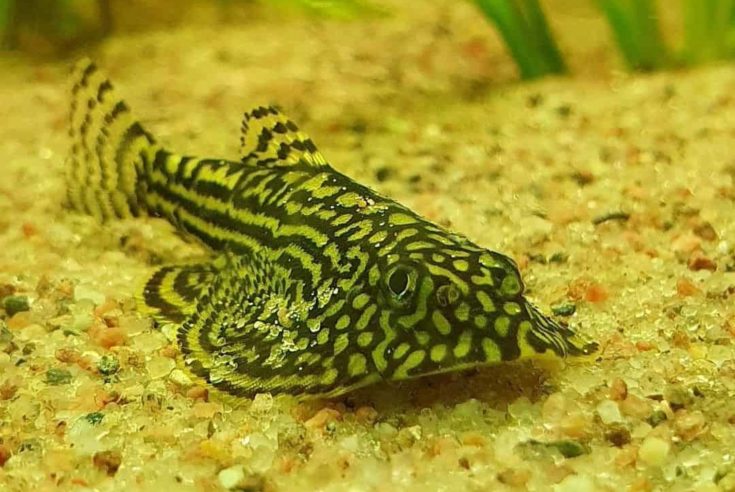
This species of Hillstream loach is a beautiful, unique-looking fish that’s sure to captivate everyone who sees it in your home aquarium!
The fish’s appearance is so strange that it’s often mistaken for a mini-stingray. Reticulated Hillstream loaches have very short barbels, which is why they’re sometimes assumed to be a species of catfish, although they are not.
The fish’s body is light yellow-gray with broad black bands that sprawl randomly across the whole fish, including the fins, creating a stunning dappled pattern. The striping on the dorsal and caudal fins tends to be more linear than that of the body.
Perfectly Adapted for the Environment
Take a look at the fish’s body shape, and you’ll immediately see why they’re so well-suited to their natural habitat, where the current is very fast. The body is streamlined and hydrodynamic, perfectly adapted to cope in fast-flowing water with minimal effort on the fish’s part.
The loach’s pelvic and pectoral fins are fanlike in shape, and the fish use those fins to move around and to cling onto solid surfaces within the habitat. A sucker mouth and flattened underbelly are also perfect for grazing on algae and withstanding the force of the water.
Size
Reticulated Hillstream loaches are small fish, measuring around 2 to 3 inches in length. Their small size makes them ideally suited for foraging for food in tiny crevices and cracks in the rocky landscape of the riverbed home.
That doesn’t mean that you won’t get to enjoy your fish, as you’ll often find all the loaches stuck firmly to the viewing panes or rocks in your tank in a group. That’s a weird site, but beautiful nonetheless!
Life Expectancy
Tank-kept Reticulated Hillstream loaches generally live for 8 to 10 years, provided that they receive a high-quality diet and the water in their tank is kept pristine and well-oxygenated.
Activity Level/Temperament
Reticulated Hillstream loaches are peaceful creatures that make a lovely addition to a community of small, non-aggressive species that share similar water requirements.
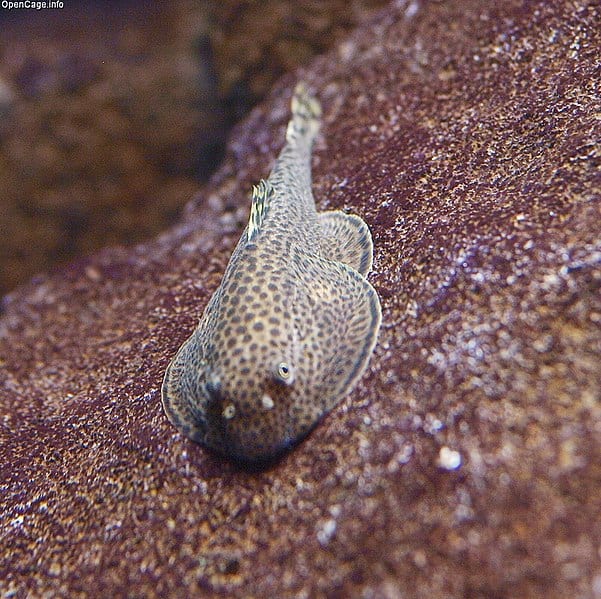
These fish are quite active foragers, spending much of their time grazing on algae, stuck to the tank glass, or rooting around among the base of plants and in rocky crevices.
Compatibility and Tankmates
Can Reticulated Hillstream Loaches Live in Groups?
Wild Reticulated Hillstream loaches are not natural schooling fish. However, when kept in a home aquarium, it seems that these little guys do prefer the company of their own kind. For that reason, I recommend that you keep a group of at least three loaches.
That said, if the bottom of the tank becomes overcrowded, territorial scuffles can break out. So, don’t add more than three loaches to your setup unless you have plenty of space.
Tank mates
Thanks to the loaches’ peaceful, amendable nature, there are quite a few suitable tank mates that you can choose to create a community tank.
Remember that these loaches prefer cooler water, so don’t choose tropical species that may not appreciate chilly conditions. There’s also the extremely fast flow rate to be considered. Many fish species don’t enjoy being buffeted around by a strong current, which will most likely stress them, leading to outbreaks of disease.
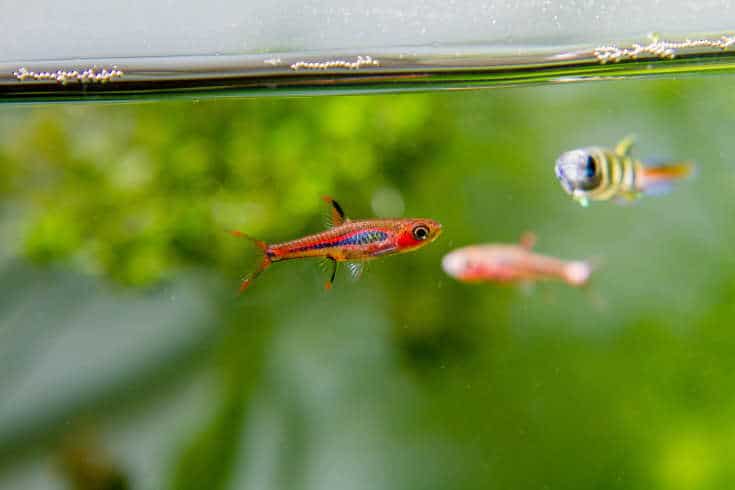
You might want to consider species such as White Cloud Minnows, Chili rasboras, Zebra danios, and Celestial Pearl danios. Generally, invertebrates such as shrimp and snails are safe to keep with Reticulated Hillstream loaches.
Fish to Avoid
Fish that are best avoided are large, territorial species such as cichlids and Oscars, and Angelfish and Tiger barbs that can be nippy and might harass and stress the loaches.
Feeding
Whatever fish species you keep, it’s essential that you provide a high-quality, nutritious diet in the correct quantity.
What to Feed Reticulated Hillstream Loaches
All Hillstream loaches are omnivores, grazing on biofilm and algae on the tank surfaces. You should also include an element of meaty protein in your fishes’ diet, such as insect larvae, bloodworms, brine shrimp, daphnia, and tubifex. Fish flakes, mini pellets, and algae wafers can also be added to the diet.
Can Hillstream Loaches Have Live Foods?
Yes, in theory, your loaches will enjoy the inclusion of some live food in their diet every now and then.
However, I would urge caution if you decide to give your fish live food.
Unfortunately, live food sometimes comes with unwanted parasites and bacteria that could attack your fish. So, always buy live food from a reputable supplier, and separate the food from the water it’s supplied in before you offer the food to your fish.
Never catch worms and the like from the environment! You don’t know what else you might be introducing to your tank.
If you’re still keen to give your fish live food and you have the time to devote to the project, you might want to have a go at raising brine shrimp in a DIY hatchery.
How Much and How Often to Feed
It’s important that you don’t overfeed your loaches, as that can cause health problems, and uneaten food will decompose and pollute the tank.
So, feed your fish twice a day, and give them only what they will eat in a couple of minutes.
Tank Requirements
You can really make the most of your loaches’ good looks by replicating their natural habitat in your aquarium. Also, most fish species do best when kept in an environment that closely mirrors the kind of setting that they enjoy in nature.
Tank size
As you’re going to be keeping a small group of loaches, you’ll need a large tank of at least 50 gallons.
The best tank shape to go for is a long rectangular aquarium rather than a tall one. That’s because loaches live exclusively on the bottom of the tank, so you need something that provides ample floor space. A long tank will also have a greater surface area, which is important for efficient gaseous exchange; these are oxygen-hungry fish.
Tank Setup
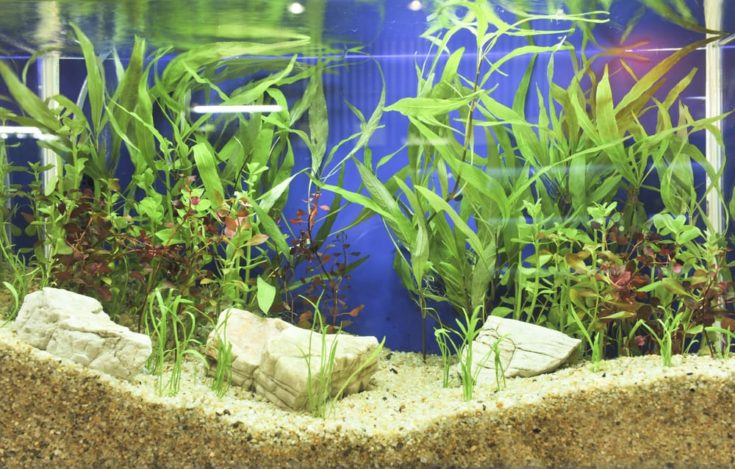
Substrate
I recommend that you use a soft, sandy substrate.
Reticulated Hillstream loaches spend the majority of their time on the bottom of the tank, foraging in the substrate. If you use coarse gravel, there’s a risk that the fish will be injured.
Decoration
Hillstream loaches prefer a heavily planted tank where they have plenty of places to hide and take refuge when they want to. Also, the base of plants provides an excellent foraging area. Java moss and Anubias barteri are good plants to use, but you can use whatever you think best suits the aquascape you’re creating.
These fish like to graze on the biofilm and algae that colonize surfaces within the tank, so be sure to include driftwood, smooth stones, and rockwork, too.
Habitat Requirements
Filtration
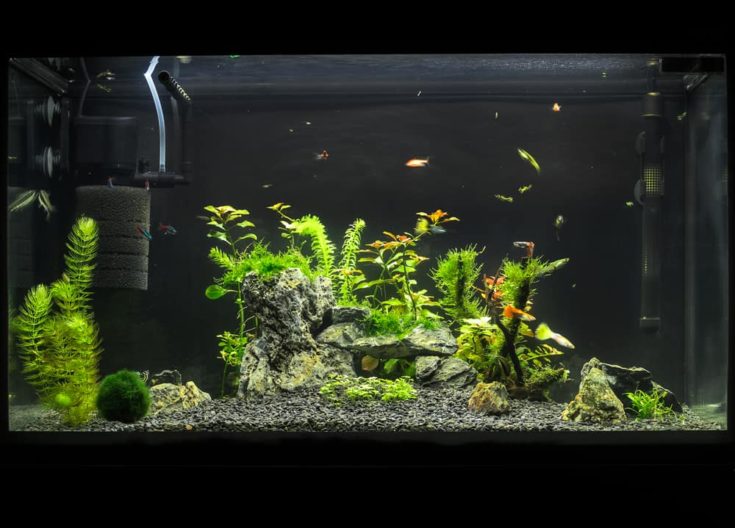
It’s essential that your tank has a highly efficient filtration system that keeps the environment pristine for Hillstream loaches.
We recommend that you use powerheads in conjunction with an external canister filter to provide the fish with the flow rate that they need, as well as keeping the water well-oxygenated.
Water Parameters
Water Temperature
Hillstream loaches prefer cooler, temperate water of between 68° and 72° Fahrenheit.
These fish do not appreciate warm water temperatures. If the water in their tank is consistently above 75° Fahrenheit, mortality will probably occur.
Water Hardness and pH Range
The aquarium water should have a hardness level of between 10 and 15 dKH, and the pH should be slightly acidic in the range of 6.5 to 7.5.
Lighting
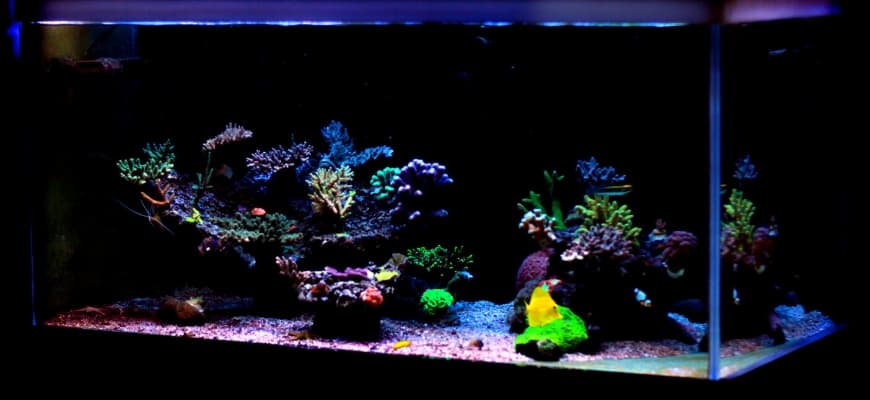
These fish don’t have any specific lighting requirements, so choose an LED lighting unit that suits the plant species you’ve chosen.
Tank Maintenance
Keeping the tank in pristine condition is essential for the health of Hillstream loaches, and extremely well-oxygenated water is absolutely crucial if these fish are to do well.
Perform 30% weekly water changes, and deep-clean the substrate by using an aquarium vacuum to get rid of fish waste, decaying plant material, and uneaten food.
As part of your aquarium cleaning duties, rinse the filter media in dirty tank water (never tap water) to remove the sludge that would otherwise clog the media and obstruct the water flow through the system.
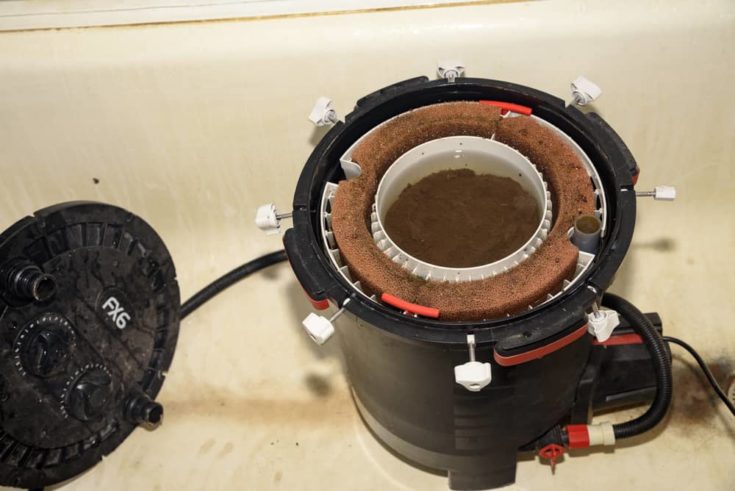
Change the filter media at regular intervals, as recommended by the manufacturer.
Test the Water
Every week, use an aquarium water testing kit to check that levels of ammonia and nitrites are at zero, and nitrates are around 20ppm. You should also check the pH and water hardness levels too.
Setting Up the Aquarium
As with most species of loach, I recommend that you don’t introduce these fish to a brand-new setup. That’s because Reticulated Hillstream loaches are fussy when it comes to water conditions, so it’s preferable to wait until the tank has had a chance to mature properly before adding them to your collection.
Before you start setting up your tank, collect everything you need. There’s nothing more frustrating than getting so far through the process, only to find that you forgot something.
You will need:
- Sandy substrate
- LED lighting unit
- Canister filtration system
- Powerheads
- Heater
- Aquarium thermometer
- Tank décor, including, including driftwood, smooth rocks, and caves
- Lots of live plants
How to set up the aquarium:
- Start by washing the substrate underneath running water to remove loose debris and dust. If you add the sand to the tank without rinsing it first, you risk ending up with cloudy water that can take ages to clear completely.
- Put the sand into your aquarium to a depth of roughly two to three inches.
- Install the filter and heater in the tank, but don’t switch them on yet.
- Fill the tank with dechlorinated tap water. To avoid scattering the sand everywhere when you pour the water into the aquarium, set an upside-down dish on the sand, and slowly pour the water over it.
- To set the nitrogen cycle in motion in the biological filter media, the water must contain some ammonia. To add ammonia to the water, you can either add a few drops of pure ammonia, put in a pinch of fish flake, or add some sand or filter media from an existing tank.

- Rinse your chosen tank décor to get rid of any dust, and arrange the decorations in the aquarium.
- Now, take your plants and remove dead stems or leaves. To prevent the loaches from uprooting the plants as they forage, use plant weights to anchor the stems securely in the sand. Leave enough space between the stems to allow for growth and spread.
- Switch on the heater and filter system. You will also need to have your tank lights on for eight to ten hours per day so that your plants will have enough light to photosynthesize.
- Now, you need to wait for at least ten days to give nitrifying bacteria a chance to colonize the tank and the biological filter media. Once that’s happened, the bacteria will process the ammonia in the water that would otherwise be toxic for your fish.
- Test the water levels. Ammonia and nitrites must both be at zero, and nitrates close to 20ppm for the tank to be cycled and safe for fish to be introduced. You may need to allow more time if the levels are still too high.
Health and Disease
Reticulated Hillstream loaches are pretty hardy fish, although they can succumb to some of the common fish diseases that afflict most species of tank-kept tropical fish.
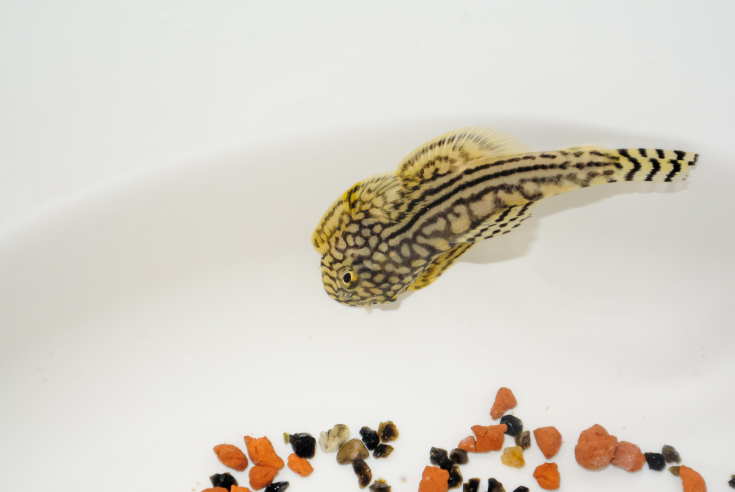
Signs of Good Health
These are quite active fish that enjoy being part of a group and going on foraging trips with their companions.
The loaches also like to graze on algae that are growing on surfaces within the tank, and you’ll often see them stuck to the viewing pane with their sucker mouths.
Red Flags
If your loaches exhibit any of the following behaviors, health problems could be brewing:
- Not eating or grazing on surfaces within the tank
- Not socializing with their conspecifics
- Inactivity
- Areas of reddened skin, ulcers, sores, ripped or bloody fins
- Flicking against objects in the aquarium
Common Health Issues and Treatment
Health Issue
Ich (White Spot Disease)
External parasites
Fungal infections
Bacterial infections
Skinny disease
Symptoms or Causes
Ich is a very common fish disease that’s also sometimes called White Spot disease.White Spot is caused by an aquatic parasite. Infected fish develop a scattering of tiny white spots across the body, fin, and gill covers and typically flick against things in the tank.
External parasites include flukes, anchor worms, and fish lice.These parasites attach themselves to the fish’s gills or skin and can often be seen with the naked eye. Infected fish typically secrete excessive mucus.
White fluffy growths on fish’s head, mouth, and body.
Ulcers, sores, bloody fins, open wounds.
Fish appear to eat normally but rapidly lose weight and fail to thrive.
Suggested Action
Dose the water with a loach-safe over-the-counter treatment.
Dose the whole tank with loach-safe anti-parasitic treatment.
Treat the water with loach-safe antifungal medication.
Quarantine affected fish; treat the tank with loach-safe antibacterial medication.
Treat the water with a loach-safe antibacterial treatment.
Health Issue
Ich (White Spot Disease)
Symptoms or Causes
Ich is a very common fish disease that’s also sometimes called White Spot disease.White Spot is caused by an aquatic parasite. Infected fish develop a scattering of tiny white spots across the body, fin, and gill covers and typically flick against things in the tank.
Suggested Action
Dose the water with a loach-safe over-the-counter treatment.
Health Issue
External parasites
Symptoms or Causes
External parasites include flukes, anchor worms, and fish lice.These parasites attach themselves to the fish’s gills or skin and can often be seen with the naked eye. Infected fish typically secrete excessive mucus.
Suggested Action
Dose the whole tank with loach-safe anti-parasitic treatment.
Health Issue
Fungal infections
Symptoms or Causes
White fluffy growths on fish’s head, mouth, and body.
Suggested Action
Treat the water with loach-safe antifungal medication.
Health Issue
Bacterial infections
Symptoms or Causes
Ulcers, sores, bloody fins, open wounds.
Suggested Action
Quarantine affected fish; treat the tank with loach-safe antibacterial medication.
Health Issue
Skinny disease
Symptoms or Causes
Fish appear to eat normally but rapidly lose weight and fail to thrive.
Suggested Action
Treat the water with a loach-safe antibacterial treatment.
Breeding
The Reticulated Hillstream loaches that you find for sale in fish stores and online are usually commercially raised by professional fish breeding operations in Asia and Eastern Europe. However, it is possible to breed these fish in the home tank with a little luck and the correct conditions.
Gender Determination
Before you can even think about breeding your Reticulated Hillstream loaches, you need to know if you have boys or girls.
All things being equal, you would expect to get a mixture of both sexes if you keep a small group of fish. However, it is quite easy to tell the males from the females.
Take a look at the fish from above and underneath, which you can do when the loaches are stuck to the viewing pane of the aquarium. Males have a much more prominent head than females. Female fish, therefore, have a much rounder front end than males. Male fish are usually slightly longer than females, too.
Spawning
When the fish are in prime breeding condition, the male will begin flirting with the females by performing a sort of “dance.” If a female finds the male’s gyrations appealing, she will stay close to him, indicating that she’s interested.
The male loach builds a nest in the substrate, fussing over the structure until he’s satisfied that it’s perfect. The female then lays her eggs in the nest, and the male fertilizes them.
It usually takes a couple of weeks for the eggs to hatch and the fry to emerge. Unlike many other fish species, Reticulated Hillstream loaches are good parents that don’t tend to eat their eggs and fry. That means you can leave the family together in their aquarium.
Availability
Reticulated Hillstream loaches are generally quite widely available from good fish stores and from online dealers and auctions for around $12 per fish.
Product Recommendations
- A fishnet
- Algae magnet
- Aquarium thermometer
- Aquarium vacuum
- Books on keeping tropical fish
- Canister filtration system
- Powerhead
- Aquarium (minimum size 50 gallons)
- Heater
- High-quality tropical fish flakes or pellets
- LED lighting unit
- Plants
- Rocks, driftwood, smooth stones, caves
- Sandy substrate
- Selection of frozen foods
- Water conditioner
In Conclusion
I hope you enjoyed our guide to keeping the unusual and beautiful Reticulated Hillstream loach.
Did you successfully raise these loaches in your home aquarium? We’d love to hear about your experiences, so tell us in the comments box below.
Please remember to share our guide if you loved it!
